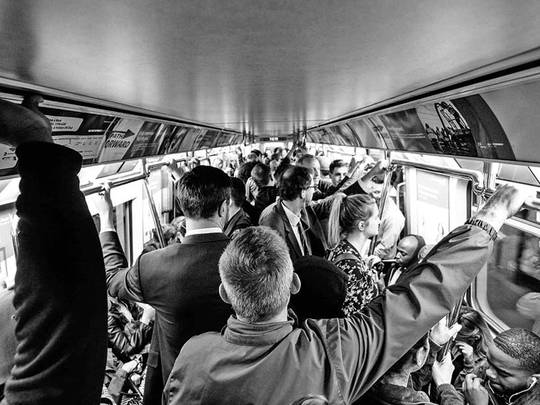
I was on the subway in New York, watching a teenager text on his smartphone, when I realised that the idiom “all thumbs” might be doomed. I’ve had any number of such moments — what some people would call “ah-ha” moments — on the subway lately. A day or so before the “all thumbs” revelation, I was reminded once again that I am what used to be called “getting on in years”: I was standing in a crowded car when my eye happened to catch the eye of an attractive young woman who was seated in front of me. She smiled. I smiled. I was on my way to thinking that maybe she had me confused with George Clooney — a mix-up that, I’ll admit, does not occur on a regular basis. Then she smiled again, and offered me her seat.
My contemplation of the future of “all thumbs” came to me on the No. 1 uptown local. The train was crowded, but I had a seat. I was the only person in the car who was reading a newspaper rather than staring at a small electronic device — a singularity that should have provided another hint about where I fit in demographically these days. I happened to be reading an article about the possibility that real estate in Manhattan will eventually become so expensive that only rich people can live there. If so, I wondered, will the phrase “inner city” no longer be a euphemism for a place where poor people live? I could envision advertisements with headlines like “Luxury Inner City Building — Co-ops Starting at $4 Million.” I could envision a gossip columnist writing, “The gala drew a glitzy, moneyed crowd from the inner city.”
Then I noticed the teenager, who was sitting across from me, texting with blinding speed. As his thumbs danced over the tiny screen, I realised that “all thumbs” cannot much longer mean clumsy with one’s hands. And I realised how much I’m going to miss it. It has always seemed to me a way of noting a deficit without being vicious about it — a description of the bumbling sitcom dad who tries to fiddle with a circuit breaker and plunges the entire house into darkness. But how can that man be labelled all thumbs if the teenager sitting across from me can use his thumbs on his smartphone fast enough to take dictation from a cattle auctioneer?
As we rattled up the West Side, I tried to think comforting thoughts. For instance, I told myself, we continued to say, “He was hoisted by his own petard,” long after anybody actually knew what a petard looked like. But by the time the No. 1 had reached 59th Street, I had started to worry about the idiom “sounds like a broken record,” referring to someone who starts talking about a single subject — his thickheaded boss, say, or the route he always takes to Woodside, Queens, when he visits his shiftless brother — and doesn’t stop until his family and friends have fled the premises.
Being old enough to read newspapers on subways, I do own some vinyl records; they’re in the cabinet, behind the cassette tapes of Frank Sinatra that I used to sing along to while I was driving. (Not to boast, but the Chairman and I happen to sing in the same key.) I know what happens when the needle gets stuck on a vinyl record. But how about that teenager I had observed texting at court-reporter speed with his thumbs? How about his children? When they are teenagers, they might never have seen a record. Their only familiarity with a broken record might be something like a record that is broken in the 100-yard dash. What does a broken record in the 100-yard dash sound like? How about a broken record in a burrito-eating competition?
Just before we reached 86th Street, I looked at my watch. Then I began to wonder whether I might be the only person in the car who told time by looking at a watch as opposed to reading the time digitally on a small device. It was a warm autumn day, and a number of people were in short-sleeves. From what I could see, almost none of them wore a wristwatch. That got me to thinking about “counterclockwise.” When all of the analogue watches and clocks are gone, will there be generations of people who don’t know what it means when the instructions say, “Turn the bolt counterclockwise”? Even now, with my watch visible on my wrist, I sometimes turn the bolt in the wrong direction. (All right. If you must know: I’ve often been described as “all thumbs”.)
At the 86th Street stop, a grey-haired gentleman entered the car and, locking his arm around one of the vertical poles, unfolded the New York Times. I noticed that he was wearing a wristwatch. Catching his eye as he held out the paper to turn a page, I nodded. He nodded. I nodded again and offered him my seat.
–New York Times News Service
Calvin Trillin’s latest book is an expanded edition of Killings.












